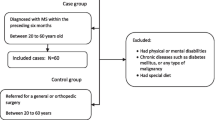Abstract
To assess the patterns of dietary (DS) and herbal supplement (HS) use in MS patients, compare use between MS patients and healthy controls and to identify potential interactions with drugs used to treat MS. This study included 279 MS subjects and 161 controls from a study of risk factors in MS. All patients received a neurological examination. All subjects provided responses to a standardized questionnaire administered during an in-person interview. A larger proportion of MS patients (82.1%) compared to controls (60.1%) used one or more DS regularly for at least 3 months (p < 0.001). There was a trend toward a higher proportion of MS patients (26.6%) versus controls (17.8%) who used HSs for more than 1 month (p = 0.038). The most common DS used after MS onset was a multivitamin (78.1%), followed by vitamin D (65.8%). Use of the majority of specific DSs increased significantly after MS onset compared to before. The proportion of controls and MS patients after MS onset who reported using an individual HS was generally similar. The most commonly used HS in patients after MS was evening primrose oil (40.4%) followed by cranberry fruit extract (35.2%). There was no evidence for associations with progressive disease course or with choice of disease-modifying treatment. Dietary supplements are used more frequently by MS patients than controls. Use tends to increase after MS onset compared to before, especially for DS. The use of HS by MS patients is only modestly greater than by controls.

Similar content being viewed by others
References
Joy JE, Johnston RB (eds) (2001) Multiple sclerosis: current status and strategies for the future. National Academy Press, Washington, DC. Available from: http://books.nap.edu/openbook.php?record_id=10031&page=R1
Yadav V, Shinto L, Bourdette D (2010) Complementary and alternative medicine for the treatment of multiple sclerosis. Expert Rev Clin Immunol 6(3):381–395
Olsen SA (2009) A review of complementary and alternative medicine (CAM) by people with multiple sclerosis. Occup Ther Int 16(1):57–70
Zhou SF, Zhou ZW, Li CG, Chen X, Yu X, Xue CC et al (2007) Identification of drugs that interact with herbs in drug development. Drug Discov Today 12(15–16):664–673
Brazier NC, Levine MA (2003) Drug-herb interaction among commonly used conventional medicines: a compendium for health care professionals. Am J Ther 10(3):163–169
Nayak S, Matheis RJ, Schoenberger NE, Shiflett SC (2003) Use of unconventional therapies by individuals with multiple sclerosis. Clin Rehabil 17(2):181–191
Somerset M, Campbell R, Sharp DJ, Peters TJ (2001) What do people with MS want and expect from health-care services? Health Expect 4(1):29–37
Stuifbergen AK, Harrison TC (2003) Complementary and alternative therapy use in persons with multiple sclerosis. Rehabil Nurs 28(5):141–147, 58
Apel A, Greim B, Zettl UK (2005) How frequently do patients with multiple sclerosis use complementary and alternative medicine? Complement Ther Med 13(4):258–263
Shirazi MM, Taleban FA, Kimiagar SM, Ghafarpoor M (2007) Dietary supplementation in Iranian multiple sclerosis patients. J Med Sci 7(3):413–417
Yadav V, Shinto L, Morris C, Senders A, Baldauf-Wagner S, Bourdette D (2006) Use and self-reported benefit of complementary and alternative medicine among multiple sclerosis patients. Int J MS Care 8:5–10
Leong EM, Semple SJ, Angley M, Siebert W, Petkov J, McKinnon RA (2009) Complementary and alternative medicines and dietary interventions in multiple sclerosis: what is being used in South Australia and why? Complement Ther Med 17(4):216–223
Sastre-Garriga J, Munteis E, Rio J, Pericot I, Tintore M, Montalban X (2003) Unconventional therapy in multiple sclerosis. Mult Scler 9(3):320–322
Clinical Pharmacology [database online] [database on the Internet]. Gold Standard, Inc. (2011) Available from: http://clinicalpharmacology-ip.com/default.aspx
Pucci E, Cartechini E, Taus C, Giuliani G (2004) Why physicians need to look more closely at the use of complementary and alternative medicine by multiple sclerosis patients. Eur J Neurol 11(4):263–267
Acknowledgments
Support was received from the National Multiple Sclerosis Society (RG3743 and a Pediatric MS Center of Excellence Center Grant), and the Department of Defense Multiple Sclerosis Program (MS090122) is gratefully acknowledged. Kerri O’Connor has nothing to declare. Dr. Weinstock-Guttman has received speaker honoraria and consultant fees from Teva Neuroscience, Biogen Idec, EMD Serono, Novartis, Pfizer, and Accorda. She also received financial support for research activities from the National Institute of Health, National Multiple Sclerosis Society, National Science Foundation, Department of Defense, EMD Serono, Biogen Idec, Teva Neuroscience, Cyberonics, Accorda, and the Jog for the Jake Foundation. These are unrelated to the research presented in this report. Ellen Carl and Colleen Kilanowski have nothing to disclose. Dr. Zivadinov has received speaker honoraria and consultant fees from Teva Neurosciences, Biogen Idec, Questcor, Genzyme, and EMD Serono; and received research support from the National Multiple Sclerosis Society, the Biogen Idec, Teva Neuroscience, Teva Pharmaceuticals, Genzyme, Questcor, Bracco, and Greatbatch. These are unrelated to the research presented in this report. Murali Ramanathan received research funding from Pfizer, the National Multiple Sclerosis Society, the Department of Defense, National Institutes of Health, and National Science Foundation. He received compensation as a consultant for Netezza, BiogenIdec, and Allergan, and for serving as an Associate Editor for the American Association of Pharmaceutical Scientists. These are unrelated to the research presented in this report.
Conflicts of interest
The authors report no conflicts of interest.
Author information
Authors and Affiliations
Corresponding author
Rights and permissions
About this article
Cite this article
O’Connor, K., Weinstock-Guttman, B., Carl, E. et al. Patterns of dietary and herbal supplement use by multiple sclerosis patients. J Neurol 259, 637–644 (2012). https://doi.org/10.1007/s00415-011-6226-3
Received:
Revised:
Accepted:
Published:
Issue Date:
DOI: https://doi.org/10.1007/s00415-011-6226-3



